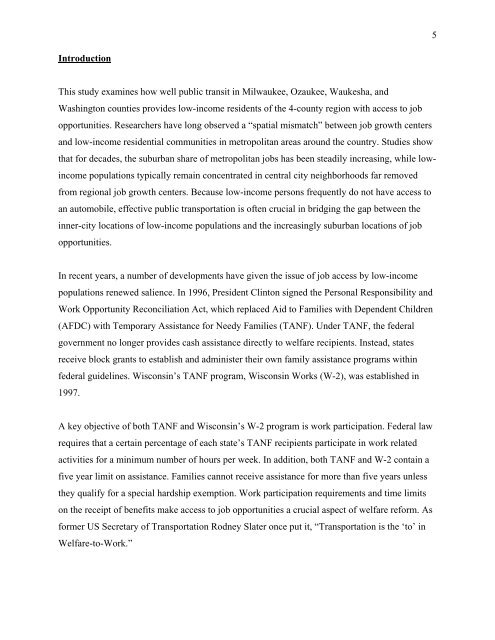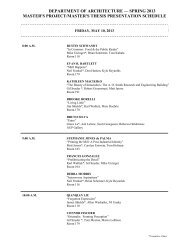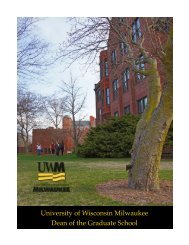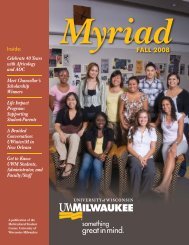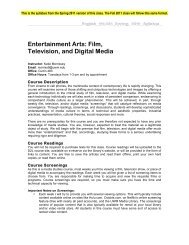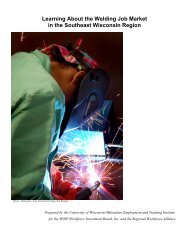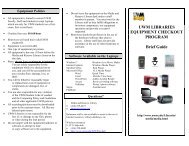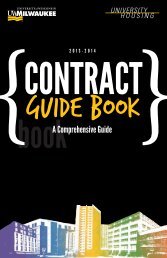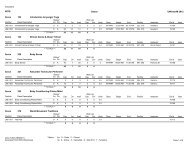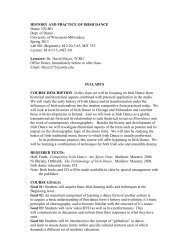Transportation Equity and Access to Jobs in ... - UW-Milwaukee
Transportation Equity and Access to Jobs in ... - UW-Milwaukee
Transportation Equity and Access to Jobs in ... - UW-Milwaukee
Create successful ePaper yourself
Turn your PDF publications into a flip-book with our unique Google optimized e-Paper software.
5IntroductionThis study exam<strong>in</strong>es how well public transit <strong>in</strong> <strong>Milwaukee</strong>, Ozaukee, Waukesha, <strong>and</strong>Wash<strong>in</strong>g<strong>to</strong>n counties provides low-<strong>in</strong>come residents of the 4-county region with access <strong>to</strong> jobopportunities. Researchers have long observed a “spatial mismatch” between job growth centers<strong>and</strong> low-<strong>in</strong>come residential communities <strong>in</strong> metropolitan areas around the country. Studies showthat for decades, the suburban share of metropolitan jobs has been steadily <strong>in</strong>creas<strong>in</strong>g, while low<strong>in</strong>comepopulations typically rema<strong>in</strong> concentrated <strong>in</strong> central city neighborhoods far removedfrom regional job growth centers. Because low-<strong>in</strong>come persons frequently do not have access <strong>to</strong>an au<strong>to</strong>mobile, effective public transportation is often crucial <strong>in</strong> bridg<strong>in</strong>g the gap between the<strong>in</strong>ner-city locations of low-<strong>in</strong>come populations <strong>and</strong> the <strong>in</strong>creas<strong>in</strong>gly suburban locations of jobopportunities.In recent years, a number of developments have given the issue of job access by low-<strong>in</strong>comepopulations renewed salience. In 1996, President Cl<strong>in</strong><strong>to</strong>n signed the Personal Responsibility <strong>and</strong>Work Opportunity Reconciliation Act, which replaced Aid <strong>to</strong> Families with Dependent Children(AFDC) with Temporary Assistance for Needy Families (TANF). Under TANF, the federalgovernment no longer provides cash assistance directly <strong>to</strong> welfare recipients. Instead, statesreceive block grants <strong>to</strong> establish <strong>and</strong> adm<strong>in</strong>ister their own family assistance programs with<strong>in</strong>federal guidel<strong>in</strong>es. Wiscons<strong>in</strong>’s TANF program, Wiscons<strong>in</strong> Works (W-2), was established <strong>in</strong>1997.A key objective of both TANF <strong>and</strong> Wiscons<strong>in</strong>’s W-2 program is work participation. Federal lawrequires that a certa<strong>in</strong> percentage of each state’s TANF recipients participate <strong>in</strong> work relatedactivities for a m<strong>in</strong>imum number of hours per week. In addition, both TANF <strong>and</strong> W-2 conta<strong>in</strong> afive year limit on assistance. Families cannot receive assistance for more than five years unlessthey qualify for a special hardship exemption. Work participation requirements <strong>and</strong> time limitson the receipt of benefits make access <strong>to</strong> job opportunities a crucial aspect of welfare reform. Asformer US Secretary of <strong>Transportation</strong> Rodney Slater once put it, “<strong>Transportation</strong> is the ‘<strong>to</strong>’ <strong>in</strong>Welfare-<strong>to</strong>-Work.”


